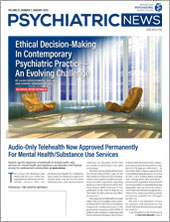Most patients receiving care for a mental health or substance use issue will respond to a question about access to firearms in a standard intake questionnaire, according to a study published in JAMA Health Forum. In fact, over 90% of individuals visiting a specialty mental health clinic answered the question: “Do you have access to guns?”
“Our team was surprised, but pleasantly surprised, by these findings,” said lead study author Julie Richards, Ph.D., M.P.H., a research associate at Kaiser Permanente Washington Health Research Institute in Seattle and affiliate professor at the University of Washington. “During prior qualitative interviews with patients and discussions with providers, we heard concerns over this question, but when we looked over the data, we found that people were willing to answer.”
Richards and her colleagues focused on data that Kaiser Permanente began collecting in 2015, when outpatient mental health clinics across Washington incorporated a question about firearm access into intake patient questionnaires. Over the next couple of years, these questionnaires began being administered to patients at primary care clinics as well. The researchers compiled data from 128,802 patients who completed these questionnaires at either a primary care or mental health clinic between 2016 and 2019.
Overall, 83.4% of patients in primary care clinics and 91.8% in mental health clinics answered the question on firearm access. Those who did not respond to this question were more likely to be older, male, live in a rural setting, and/or have a recent substance use disorder diagnosis. Among those who responded, 20.9% of patients in primary care clinics and 15.3% in mental health clinics reported having access to firearms. Those with firearm access were more likely to be male and live in a rural or suburban setting. Patients who reported a previous suicide attempt were far less likely to report firearm access than those without a suicide attempt history.
J. John Mann, M.D., the Paul Janssen Professor of Translational Neuroscience (in Psychiatry and in Radiology) at Columbia University, said the findings represent a step in the right direction when it comes to suicide prevention. Mann, who was not involved with this study, recently completed a meta-analysis which found that talking with patients on firearm safety is an effective and scalable suicide prevention strategy (
Psychiatric News). “We [physicians] are not afraid to give patients advice on smoking or parachuting or any other number of activities that carry an increased risk of illness or injury; gun safety should be no different.”
Including data on firearm access in electronic medical records could help to flag individuals who may also be dealing with depression and alert physicians that they should consider a discussion on firearms.
Those sentiments were echoed by Katherine Hoops, M.D., M.P.H., an assistant professor of pediatric critical care medicine at Johns Hopkins University, in an editorial accompanying the study. “If we screen, we must be prepared to intervene,” she wrote. “Unfortunately, clinicians are currently ill equipped to provide this counseling, with only about 20% of pediatric residents in one survey reporting that they had ever received any didactic education on firearm injury.”
It is likely more places will follow Kaiser’s lead and add firearm questions to patient questionnaires, Hoops continued. Clinics need to prepare their staff with the necessary tools for how to respond to the information they uncover—from how to deliver messages on a sensitive subject in a nonjudgmental way to how to remain up to date on state policies involving gun storage.
Additional efforts also need to be made to reach the 15% to 20% of people who did not answer the question about firearm access, Mann noted. “I could not help but notice that the factors associated with owning a gun were much the same as those associated with not answering the question,” he said. “There are many people we still need to reach.”
Richards acknowledged the gaps in the data; in addition to those who did not respond to the firearm access question, it is also possible that some patients unknowingly or deliberately answered the question incorrectly.
“[W]e can’t say these responses reflect the true state of firearm ownership among our patients,” Richards said. “I think it is more helpful to think about this study as one important step toward learning how to support firearm suicide prevention practices.”
Her team is analyzing data from another round of qualitative interviews that includes patients who did not respond to the firearm access question. “We hope to learn more about how to improve this process and encourage openness about firearm access,” she said.
This study was supported by the Kaiser Permanente’s Office of Community Health as part of its Firearm Injury Prevention Program. ■
“Self-Reported Access to Firearms Among Patients Receiving Care for Mental Health and Substance Use” is posted
here.
The editorial, “Opening the Door to a Discussion on Gun Safety,” is posted
here.

